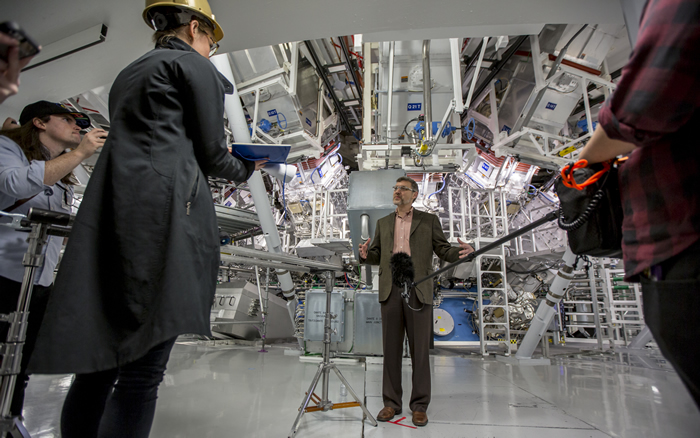NIF & PS People - 2017
January
Ryan Sacks: Designing NIF Targets
National Geographic Film Crew Visits NIF
Promoting STEM at Hart Middle School
LLNL volunteers brought the NIF & Photon Science “Laser Roadshow” to the Thomas S. Hart Middle School in Pleasanton, California, on Jan. 19 to participate in an evening of STEM (science, technology, engineering, and math).
The Roadshow, consisting of interactive laser demonstrations and a virtual reality tour of NIF, has visited schools, museums, and science fairs around the country to bring awareness and education to students and the public about lasers and how they function. NIF&PS community outreach coordinator Henry Hui arranged the visit, and LLNL mechanical engineers Stephen Hayes and Alex Aguirre manned the Laser DJ and Laser Light Fountain stations. Kendra Ruiz treated the students to the virtual tour of NIF and led them through a fact sheet describing the facility.
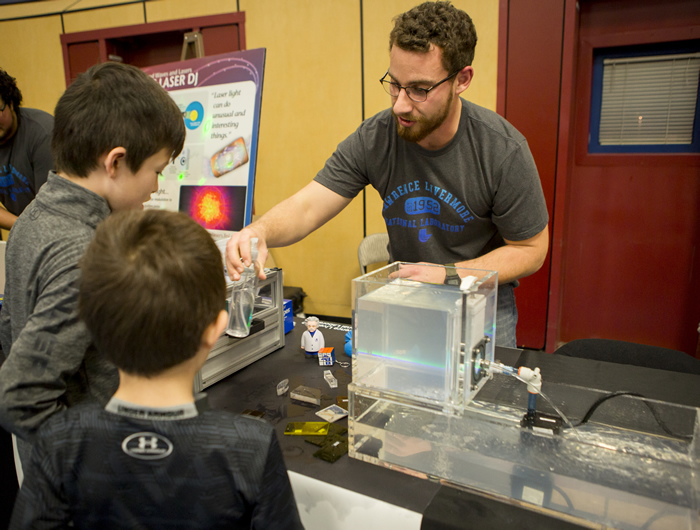 LLNL engineer Stephen Hayes uses the Laser Light Fountain to demonstrate color mixing and the principle of total internal reflection, which allows the laser light to follow the falling water.
LLNL engineer Stephen Hayes uses the Laser Light Fountain to demonstrate color mixing and the principle of total internal reflection, which allows the laser light to follow the falling water. 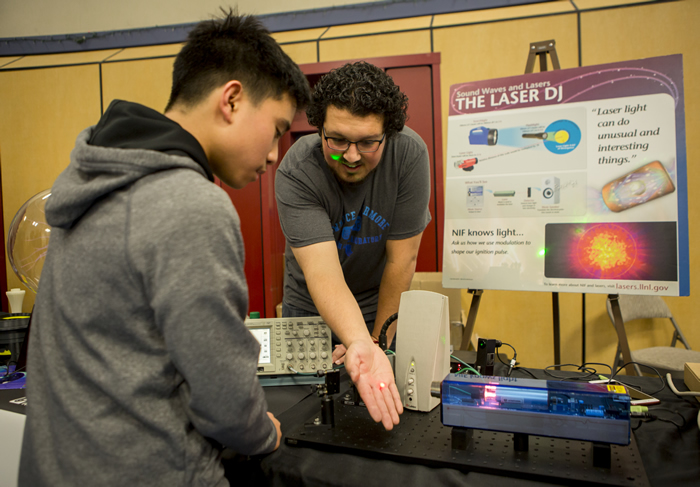 Alex Aguirre shows a student how a modulated laser beam transmits music through air—or is silenced if the beam is blocked.
Alex Aguirre shows a student how a modulated laser beam transmits music through air—or is silenced if the beam is blocked. 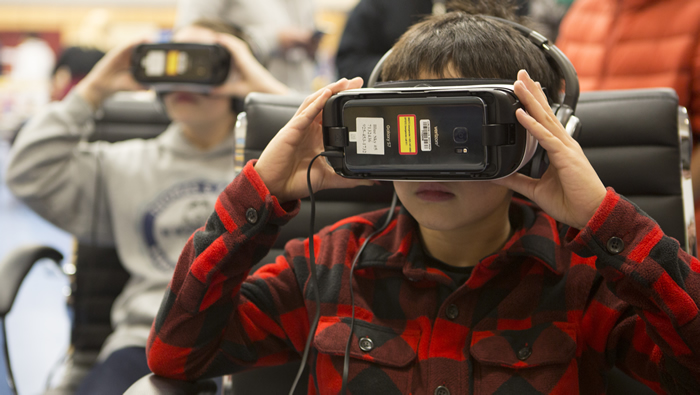 Hart Middle School students pay a virtual visit to NIF. Credit: Jason Laurea
Hart Middle School students pay a virtual visit to NIF. Credit: Jason Laurea Ryan Sacks: Designing NIF Targets
LLNL postdoctoral fellow Ryan Sacks helps design new target capsules for NIF ignition experiments. The Laboratory’s postdoc program provides opportunities for recent graduates to conduct world-class research in an exciting, diverse, and often interdisciplinary environment. Postdocs at the Laboratory are involved in basic science as well as applied science and technology for both research and development. Postdoctoral fellows are selected for their expertise, capability and enthusiasm for working at an institution that places a premium on scientific creativity and innovation.
Introducing Postdoc Ryan Sacks
Hometown: Portage, Michigan
Educational background: Bachelor’s degree in physics from Case Western Reserve University; M.S. and PhD in nuclear engineering from the University of Wisconsin-Madison.
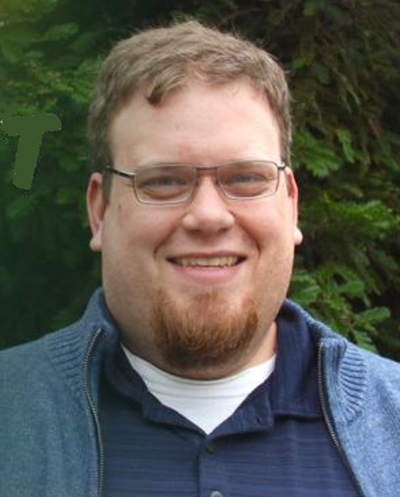 Ryan Sacks
Ryan Sacks Previous experience: Sacks came to LLNL after graduate school, where his thesis topic focused on a collaboration with the Laboratory doing simulations for laser-driven inertial fusion energy research. Previously he was a summer graduate scholar at LLNL and worked as an experimentalist on the Cryogenic Dark Matter Search (CDMS) and the Large Underground Xenon (LUX) dark matter project as an undergraduate at Case Western Reserve University.
LLNL Group/Division/Directorate: Weapons and Complex Integration (WCI), Design Physics
When did you start at the Lab?
Summer of 2010 as a summer scholar, and I started as a full-time postdoc in January 2015.
What are you working on at the Lab?
I am engaged in research centering around (capsule-fuel) mix in National Ignition Facility capsules. I have two separate projects, the first is helping to design a new “pusher” single-shell capsule that will be used to study the impact of mid-Z (mid-atomic number) material mixing in NIF implosions. This is important if we want to design a capsule that will achieve ignition but uses heavier material, like gold or tungsten, as a part of the capsule. The second is using various mix models in the ARES (Advanced Radiographic & Energetic Systems) code to simulate previous NIF capsule implosions and see if the work can be successfully replicated, and what it tells us about the theory behind mix.
What are you involved in at the Lab besides your research?
I am president of the Lawrence Livermore Postdoc Association (LLPA), where I have a number of different responsibilities: I organize the brown-bag lunches, help get the word out about all the various programs and events that we sponsor, organize the monthly meetings and write the agenda for them, and coordinate with other members of the LLPA council, most notably VP Madison Martin, Kris Kulp and Christine Zachow.
What interested you in the Lab?
Since I worked on laser inertial fusion energy as a graduate student, I became intensely interested in the inertial fusion work being done here at the Lab. Material mixing is something I came to late in my graduate career as we attempted to modify our 1-D code at Wisconsin to include a version of the K-L (Kullback-Liebler) model that is used widely here at the Lab to simulate mixing. Going to the annual APS (American Physical Society) Division of Plasma Physics meeting for three years let me see what work was being done and increased my interest level. My uncle, Richard Sacks, also works here. He encouraged me to apply for a summer position in 2010. He works over in NIF, but forgives me for being in a different directorate.
What do you enjoy most about the Lab?
I enjoy the challenging projects and collaborative atmosphere. Working as part of a group helps me feel like my efforts are valued, and everyone here is willing to help when you ask it, as long as they’re not swamped themselves. Also, the balance between work and personal life is great. Some of my friends who are still early on in their careers don’t have nearly as much freedom of hours or vacation as I do.
What have you learned since joining the Lab?
I have learned that the Lab is a huge organization and that the fusion component is only a part of the important work that is being done here. The things that they are doing with additive manufacturing are absolutely fascinating to me.
What has been your biggest accomplishment so far?
I am an Eagle Scout in the Boy Scouts of America, and I consider that an accomplishment that not many people can lay claim to.
What was your first job?
At 13, I spent the summer de-tasseling corn. Basically you ride around on baskets hanging from the arms of a tractor while it drives through the corn fields, yank out the tassels (the part that has the seed) and throw them on the ground.
Who/what inspired you to pursue a career in a STEM (science, technology, engineering and math) field?
My father has a PhD in chemistry and was always encouraging my brother, sister and me to take an interest in science. He would come to our classes in elementary school and give demonstrations, including using liquid nitrogen. In high school, I took science and math courses in the Kalamazoo Area Mathematics and Science Center, which locked in my interest in physics thanks to my junior-year teacher, Mr. Sinclair. The center had a program for upperclassmen to do research with various mentors around town, and in my senior year I was lucky enough to work with Emanuel Kamber at the particle accelerator at Western Michigan University. I even presented my work at an APS meeting in 2005 as a high-school student.
What do you enjoy doing in your spare time?
I play with my cat, read as many fantasy, science-fiction and Roman/Greek history books as I can, play computer games with my friends, play board games with my wife, Sara, and go hiking.
Where do you see yourself in 10-20 years?
I’m not quite sure; in all likelihood I see myself here at the Lab, leading a project to design a new ignition or mix experiment. There is a small chance I might be a professor at a university, but I’d rather stay at LLNL.
What book do you think everyone at the Lab should read?
Plastic Fantastic by Eugenie Samuel Reich. It’s a book that investigates how a researcher at Bell Labs, Jan Hendrik Schon, fabricated the results of his work to fool pretty much everyone in the scientific community. It’s an important reminder that we as scientists must hold ourselves to a high ethical standard. Here at the Lab we are counted on to ensure that the country remains safe and secure, so we must always make sure we are transparent (within reason) in our methodology and triple-check our work.
What is the best movie that you’ve seen in the last year?
“The Martian.” I loved the book. The movie closely followed it and was highly entertaining. But seriously, how much money have we spent saving Matt Damon?
Who are your heroes?
Jim Lovell and my father. Mr. Lovell, because his drive and dedication, first as a fighter pilot and then as an astronaut, showed me that if you work hard at your goals, you can achieve them. Watching the movie “Apollo 13” when I was younger and reading his book, Lost Moon, were inspirations to me. My father is my hero because he always had time to tell me why what he was doing was important. Whether it was when he was playing a game, changing the oil in the car, building an elaborate handmade wooden desk for me or when he was doing a science experiment, he always had time for me. He showed me that attention to detail pays off and that hard work is rewarded.
National Geographic Film Crew Visits NIF
A crew from National Geographic interviewed NIF & Photon Science Principal Associate Director Jeff Wisoff and NIF Director Mark Herrmann during a visit to the National Ignition Facility on Jan. 13 to film for an upcoming documentary series titled, “Origins.”
Each episode of the series looks at fundamental aspects of the human experience (fire, war, shelter, exploration and more). NIF will be featured in a segment of the “Fire” episode, which explores the story of humankind’s efforts to harness the process of nuclear fusion. The series is scheduled to air in March.
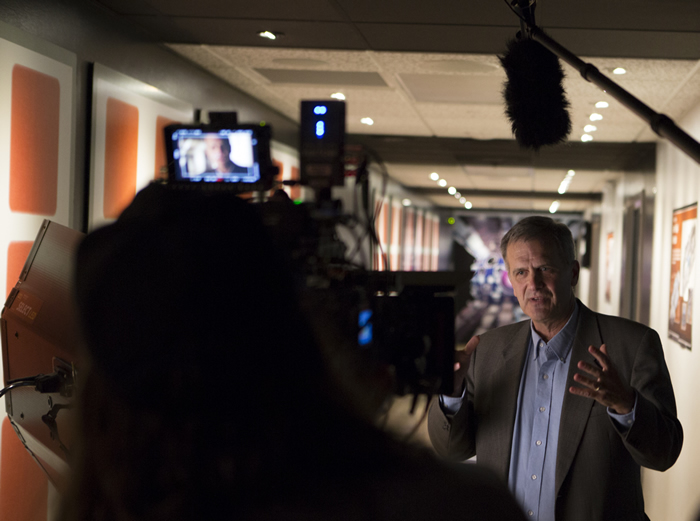 (Above) The National Geographic film crew zooms in on Jeff Wisoff. (Below) Mark Herrmann discusses NIF fusion experiments in front of the NIF Target Chamber. Credit: Jason Laurea
(Above) The National Geographic film crew zooms in on Jeff Wisoff. (Below) Mark Herrmann discusses NIF fusion experiments in front of the NIF Target Chamber. Credit: Jason Laurea